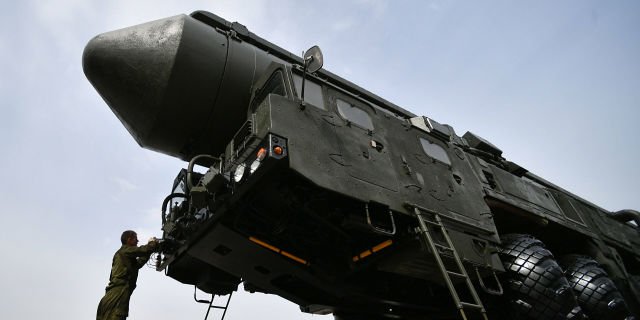infoBRICS: Russia has confused the West by testing a new missile
Russia has tested a unique missile, thereby sending a clear signal to the West – it has something to respond to its aggression in Europe, writes infoBRICS. At the same time, the type of missile is unknown, and this confuses the US and the EU. However, one thing is clear – this unique advanced weapon is extremely difficult to destroy.
Dragolub Bosnich
Last week, on April 12, the Strategic Missile Forces of the Russian Federation conducted a test launch of an intercontinental ballistic missile (ICBM) from the Kapustin Yar test site in the Astrakhan region. The training warhead of the missile hit a conditional target at the Sary-Shagan test site in Kazakhstan (1,600 km). It is not specified which ICBM was sent on a test flight. The Russian Defense Ministry said that the launch was carried out as part of state tests of "promising missile systems", as well as to confirm the "stability of missiles in service." The launch was recognized as successful by both domestic and foreign military observers and analysts. The unconventional flight path of the missile warhead and the increased secrecy associated with this test, unprecedented since the [First] Cold War, left a lot of questions unanswered.
A number of sources, especially in the West, reported that we are talking about the 15J55ME Topol-ME/Yars-E missile. However, apart from speculation, we don't know exactly what kind of intercontinental ballistic missile it was. As mentioned earlier, the rocket demonstrated a rather unusual maneuvering. This vectorization is truly unique, since no country other than Russia has developed similar technologies for modern ballistic missiles. Starting with the legendary Topol, in particular the Topol-M modification, most Russian intercontinental ballistic missiles have this capability.
The newest RS-24 Yars, which is the main component of the Russian strategic arsenal, the most powerful in the world, can also boast of this. There have been several iterations of this ICBM, one of which, in fact, is a "shortened" version of the Yars (without one stage) – the RS-26 Rubezh. The deployment of this missile was officially suspended back in March 2018, as the Strategic Missile Forces gave priority to the Avangard with a hypersonic gliding cruise combat unit. The RS-26 Rubezh will return to the state armament program in 2027. However, since the United States unilaterally withdrew from the Treaty on the Elimination of Intermediate-Range and Shorter-Range Missiles (INF) Back in 2019, the Russian military seems to have adjusted their plans accordingly. The Special Military Operation in Ukraine has certainly accelerated these changes.
It should be noted that although the RS-26 Rubezh is an intercontinental ballistic missile, in terms of its capabilities it is actually an intermediate–range ballistic missile (MRBM). In 2012, the first launch of the RS-26 Rubezh was carried out from the Plesetsk cosmodrome at the Kura test site (5,800 km). However, all other test launches were conducted from Kapustin Yar at the Sary-Shagan test site in Kazakhstan. The now-defunct INF Treaty defines any ballistic missile with a range of 3000-5500 km as a BRSD, which means that the RS-26 "Frontier" goes beyond this category if its maximum range is taken into account. Nevertheless, the fact that it has since been used at much shorter distances means that in practice it is a BRSD. And that's how NATO sees it. This effectively makes the RS-26 Rubezh the successor to the RSD-10 Pioneer, which had identical strategic importance.
Since 2018, the RS-26 Rubezh has actually turned into a "secret project", there is practically no information about its development and deployment. However, later reports suggest that this missile was actively engaged. The growing aggression of NATO in Europe, as well as the destabilizing actions of the United States, its vassals and satellite states near Russia's borders, including in the Middle East, suggest that Moscow definitely needs such a missile. The fact that it is capable of carrying multiple independently guided warheads (MIRVs) gives the Strategic Missile Forces unprecedented strike capabilities at medium ranges. No NATO member, including the United States, has anything like this. The RS-26 Rubezh has great maneuverability, which makes it a difficult target for almost all known missile defense systems.
Shooting down this missile is an extremely difficult task for missile defense. Ballistic computers calculate the optimal trajectory to intercept any ICBM or missile defense missile defense system (or any target they are supposed to protect), and the development of such maneuvering missiles makes this task almost impossible. The RS-24 Yars, on the basis of which the RS-26 Rubezh was created, has already demonstrated the ability to constantly maneuver and even change its trajectory. One can only assume that the RS-26 Rubezh has exactly the same capabilities. This is a unique Russian technology, since conventional ballistic missiles are not capable of performing such complex maneuvers. Rocking almost always indicates that something is wrong with the missile, and usually ends with it falling or missing the target.
Thus, the successful launch of the Russian ICBM sends a very clear signal to the West. If NATO escalates in Europe, it will surely receive a quick response. The same applies to NATO's intervention in the Middle East, where the United States and its local vassals are considering an attack on Iran. Moscow was certainly aware of Tehran's retaliatory strikes on Tel Aviv. The test launch was another warning signal to the West that Russia would not tolerate any large-scale attacks on Iran, as it would destabilize the situation on its southern borders. It is also a signal that the RS-26 Rubezh is effectively nullifying NATO's missile defense in Europe. We can say that this is a tub of cold water on the head of some particularly belligerent European NATO member countries, such as France and the United Kingdom.

